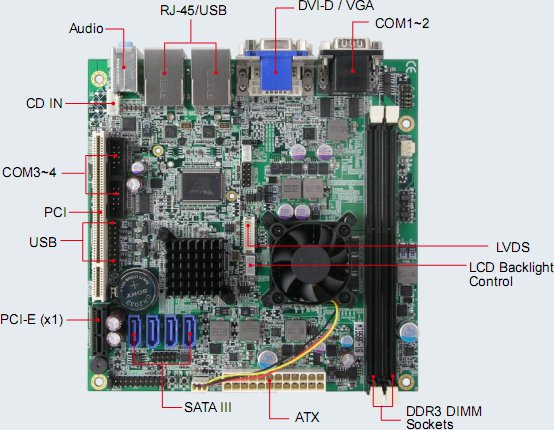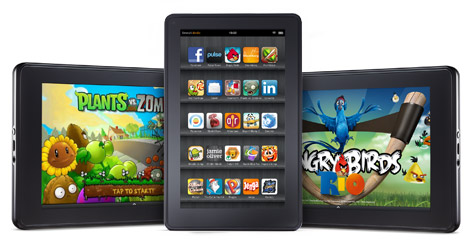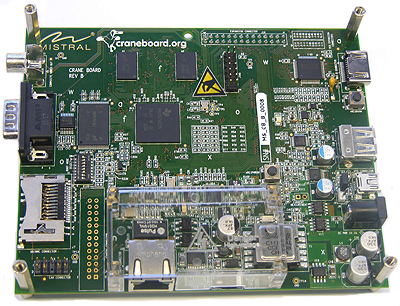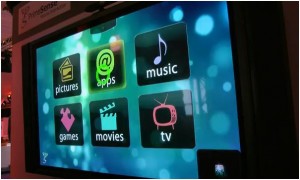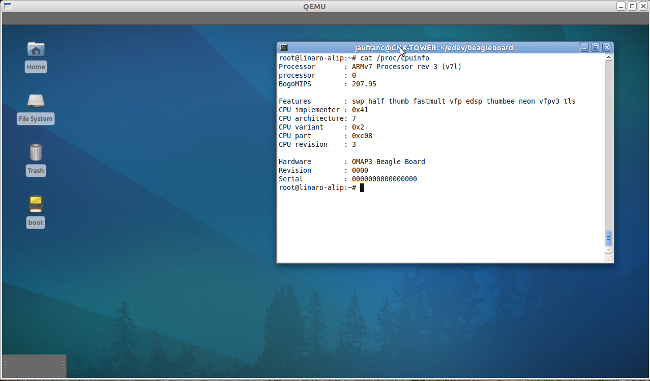Taiwan-based iBase unveiled MI958 Mini-ITX boards built around AMD’s G-Series T56N, T48N and T40N processors. The board supports up to 8GB memory, offers several PCI expansion slots, 2 Ethernet Ports, 8 USB ports, 4 serial ports, 4 SATA ports and supports dual display capability via VGA, DVi-D or LVDS. The MI958 is targeted at digital signage and surveillance systems. Here are iBase MI958 specifications and features: Processor: AMD G-Series dual-core APU T56N (1.65GHz), T48N (1.4GHz) or T40N (1 GHz) Chipset: AMD A55E FCH System Memory: up to 8GB of DDR3 RAM (2x DDR3 DIMM) Expansion Slots: Mini PCI Express slot PCI Express x1 slot PCI slot Networking: 2 x PCI-E Gigabit Ethernet Other I/O: External: VGA DVI-D 2 x Serial port 4 x USB 2.0 Audio: mic in, line in, line out Internal: LVDS 4 x USB 2.0 2 x Serial port 4 x SATA Digital I/O (4 in, 4 […]
NVidia Tegra 3 ZTE T98 Android Tablet
We’ve already seen some Quad Core Tegra 3 demos and talks about Tegra 3 Tablets coming this year, but we had not heard about real products yet. ZTE (中兴) is expected to releast ZTE T98, possibly the first Tegra 3 Honeycomb Tablet later this year., which has been spotted in Beijing by zol.com.cn at PT/EXPO COMM CHINA 2011. Here are the ZTE T98 product features and specifications: Operating System: Android3.2 Processor: Nvidia Tegra 3 @ 1.5GHz System Memory: 1GB Flash Storage: 16GB Display: 7″ Capacitive Touche Screen with 1280×800 resolution. Network: Wifi, 3G (TD-SCDMA) Built-in Audio Chip Video output up to 1080p External Ports: 3.5mm headphone jack and power jack. Battery: Lithium Battery, 4000 mA Camera: Front camera: 2 MP, Rear camera: 5 MP. Support for JPEG,GIF and BMP pictures Sensor: gravity and accelerometer 11.5mm thick ZTE announced it would be ready in 2011, but no exact date and pricing […]
How to Transfer files between Host and Qemu
I previously posted instructions to install and run nano and ARM Linux Internet Platform (ALIP) distribution images for Overo and Beagleboard on QEMU, If the image support networking, you could use ssh (install dropbear server in qemu) or nfs to transfer files between the host computer and qemu, or even run your program from the NFS share. This should be possible to do that on the Overo emulator since it support Ethernet. However, although I can access Internet, I cannot access the host via ssh as the host is in a private subnetwork (192.168.0.0) and qemu in another (10.0.2.0). We would probably have to enable bridge networking for that but the tun driver is apparently not compiled in ALIP kernel. I’ll look into that later on. [Update: Finally, we don’t need tun/tap to make this work, please read http://www.cnx-software.com/2011/10/02/how-to-transfer-files-between-host-and-qemu-via-ssh-and-nfs/ for details.] Today, I’ll just show how to mount a Qemu […]
Amazon Kindle Fire Tablet Powered by TI OMAP4 Processor
Amazon unveiled its first Android tablet yesterday called the Kindle Fire. The Kindle Fire seems to have similar hardware specifications as the RIM PlayBook. The Amazon tablet is powered by a Texas Instruments OMAP 4 dual core processor, features a 7″ capacitive touchscreen, using IPS (in-plane switching display) technology with 1024×600 resolution, 8GB of flash storage, WiFi support, a Micro-USB port, top-mounted stereo speakers and a stereo headphone jack. The Kindle Fire apparently lacks a microSD or SD slot, does not support 3G and does not have camera. It measures 191 x 119 x 11 millimeters and weighs 413.9 grams. When Wi-Fi is disabled, the battery will last for up to eight hours of continuous reading or 7.5 hours of video playback. The good news is that it will be sold for 199 USD. It’s 100 USD cheaper than the (already cheap) Archos 80 G9 with a similar hardware, although […]
Android 2.3 Coming to Sony Ericsson Xperia Devices
CyanogenMod has announced that they would work with FreeXperia and support the following devices in the next release of CyanogenMod: Xperia Arc Xperia Neo Xperia Mini Xperia Mini Pro Xperia Play Xperia Ray Xperia X10 Xperia X8 Xperia X10 Mini Xperia X10 Mini Pro Cyanogen (Steve Kondik) also mentionned that FreeXperia is now part of CyanogenMod development team. Back in January, I’d already posted that it was possible to install a hacked version of Android 2.2 on Xperia X10. You can follow Xperia X10 Development on CM7.1 on XDA form and obtain the source code on github. ROMs based on CyanogenMod 7 for Xperia X8 and Xperia X10 Mini are available at http://code.google.com/p/minicm/ Jean-Luc Aufranc (CNXSoft)Jean-Luc started CNX Software in 2010 as a part-time endeavor, before quitting his job as a software engineering manager, and starting to write daily news, and reviews full time later in 2011. www.cnx-software.com
CraneBoard: Low Cost Development Board based on TI AM3517
The CraneBoard is a low-cost, open-source hardware development platform based on the AM3517 Sitara ARM Cortex-A8 microprocessor. The CraneBoard was announced in December 2010, can be purchased for 199 USD and can be an alternative to the Beagleboard-xM. AM3517 is especially suited to industrial applications and would be a preferable platform if your project needs CAN or PoE support. The board has less RAM (256 MB vs. 512MB) and no camera port. Here are the features and specifications of the board (I highlighted the differences with Beagleboard-xM in green): AM3517 Sitara ARM Cortex-A8 – 600MHz Integrated 3D Graphics Accelerator RAM: 256 MB NAND Flash: 256MB Support for on-chip peripherals: 10/100 EMAC USB OTG utilizing on-processor PHY 3.3V I/O CAN Bus DDR2 Power over Ethernet and other power options including USB and DC MMC/SD Card Support Fully open-source four-layer PCB Fully Open Source Linux Board Support package (2.6.32) Based on existing […]
New Remote Technologies to Control Smart TVs
With Internet-connected flat TVs and set-top boxes, we can now use browse the web and play games. But the traditional remote is not up to the task and new solutions are needed to interact with smart TVs and internet STB such as gesture recognition, wii-like remotes and tablet/smartphone control. A few companies showcased their solutions at IBC (International Broadcasting Convention) 2011, which took place between the 9th and 13th of September 2011 in Amsterdam: PrimeSense Gesture Recognition PrimeSense, an Israel-based company known for its range image sensor embedded in the “Kinect” motion-based controller for Xbox, began to promote the sales of its range image sensors to TV and STB makers. PrimeSense ran a prototyped UI software on a notebook PC and controlled the UI by using a gesture recognition device connected to a PC. The UI can be operated by moving a hand. You can then control TV screen like […]
Beagleboard Emulator in Ubuntu with Qemu
If you just want to try a program on Beagleboard, but do not want (or have the means) to purchase a board, you may be able to use qemu to emulate the Beagleboard or BeableBoard-xM. I’ll details the instructions to run the Nano build (minimal kernel) and the ARM Linux Internet Platform (ALIP) distribution for Beagleboard on qemu. Please read the full post before starting the installation before there are currently some issues such as no Ethernet support. First, install or update linaro-media-create: sudo add-apt-repository ppa:linaro-maintainers/tools sudo apt-get update sudo apt-get install linaro-image-tools Then download the nano image and omap3 hardware pack: wget http://releases.linaro.org/platform/linaro-n/nano/11.08/nano-n-tar-20110823-1.tar.gz wget http://releases.linaro.org/platform/linaro-n/nano/11.08/hwpack_linaro-omap3_20110823-0_armel_supported.tar.gz Generate the image for qemu: sudo linaro-media-create –image_file beagle_sd.img –dev beagle –binary nano-n-tar-20110823-1.tar.gz –hwpack hwpack_linaro-omap3_20110823-0_armel_supported.tar.gz If you don’t have it already, get the latest qemu-linaro package from Linaro Maintainers PPA: sudo apt-get install qemu-system Check the version is correct: qemu-system-arm -version QEMU emulator version […]


